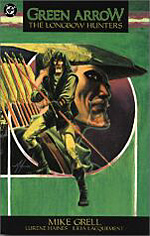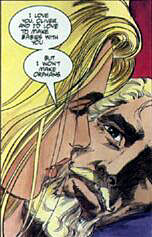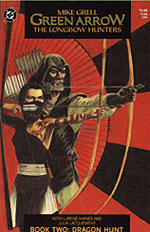>> The Friday Review: The Losers: Ante Up
>> The Friday Review: Marvels
More...

 Writer/Artist: Mike Grell
Writer/Artist: Mike Grell
Art Assistant: Lurene Haines
Letterer: Ken Bruzenak
Colourist: Julia Lacquement
Price: $14.95
Publisher: DC Comics
ISBN: 0930289382
It's been said that the best cure for a hangover - so this teetotaller has been told - is the proverbial 'hair of the dog that bit you.' If so, then GREEN ARROW - THE LONGBOW HUNTERS has quite a bite.
I've made mention before of that cluster of books - the Class of 1986 - that redefined what mainstream superhero comics could be about. And, as I've also already pointed out, the major publishers took this to mean they should include liberal dashes of sex, violence and coarse language in their stories. (Well, as coarse as the conservative political environment of the late 1980's would allow.) Rightly or wrongly, LONGBOW HUNTERS has often been held up as a prime example of this, but what many fail to take into account is that beneath the surface elements, there lies an effective action-thriller.
Mike Grell was already well established as a writer and artist of some repute when LONGBOW HUNTERS was originally published in 1987, with such renowned works as THE WARLORD and JON SABLE: FREELANCE behind him. Taking the impetus from editor and friend Mike Gold, Grell opted to redefine Oliver Queen as an 'urban hunter', and thus deal with real-world issues - a sharp contrast to the super-villains and alien invasions that were commonplace during Green Arrow's adventures up until that point.
 To underline the dramatic arc, LONGBOW HUNTERS can be summarised thus: "Green Arrow grows up". Here, he's neither the playboy dilettante nor the social crusader of previous stories; Queen has come to realise that he's getting older, and as such needs to step back and take stock of his life with long-time girlfriend Dinah Lance, the Black Canary. Of course, such introspection doesn't last long, as crimes of an everyday nature soon make their presence felt (serial killers and drug dealers) - but they soon give way to transgressions of a far greater sort...
To underline the dramatic arc, LONGBOW HUNTERS can be summarised thus: "Green Arrow grows up". Here, he's neither the playboy dilettante nor the social crusader of previous stories; Queen has come to realise that he's getting older, and as such needs to step back and take stock of his life with long-time girlfriend Dinah Lance, the Black Canary. Of course, such introspection doesn't last long, as crimes of an everyday nature soon make their presence felt (serial killers and drug dealers) - but they soon give way to transgressions of a far greater sort...
What places LONGBOW HUNTERS a notch above standard superhero fare is the complexity of the plot - not Byzantine to the point of distraction, but it's a plot that benefits from the reader paying close attention. Much of the backstory has its roots in both the Second World War and Vietnam, as well as touching on the then-current Iran/Contra scandal. Such use of real-world events gives LONGBOW HUNTERS depth and verisimilitude, if not a much-needed sense of believability. That said, in other respects, LONGBOW HUNTERS is a shade too realistic for its own good.
The most controversial sequence in the book involves Dinah being captured and tortured by the drug dealers she was chasing, with the implication that she had been sexually assaulted. While Grell has gone on record to state that no such assault occurred, those few pages do give the reader a sense of disgust and outrage, leading us to empathize with Queen when he takes matters into his own hands. Grell intended this to be a moment of transition for Queen, defining both Queen's future methodology (i.e. getting rid of the trick arrows and adopting a greater use of force) and the way Grell would handle the character.
 It's apparent that Grell has a great deal of affection for Queen, as he gets the lion's share of the 'cool scenes' in LONGBOW HUNTERS. The climax, especially, is worth noting for its action-movie flair and pyrotechnics. Sometimes though, Grell falls into the trap of having Queen acting tough, interrogating and intimidating lowlifes in order to get results. Suffice to say, if I wanted to watch a Dirty Harry flick, I'd rent one. Also, some of the prose Grell employs is overly lurid and detracts from the intended seriousness of the plot.
It's apparent that Grell has a great deal of affection for Queen, as he gets the lion's share of the 'cool scenes' in LONGBOW HUNTERS. The climax, especially, is worth noting for its action-movie flair and pyrotechnics. Sometimes though, Grell falls into the trap of having Queen acting tough, interrogating and intimidating lowlifes in order to get results. Suffice to say, if I wanted to watch a Dirty Harry flick, I'd rent one. Also, some of the prose Grell employs is overly lurid and detracts from the intended seriousness of the plot.
In contrast, Grell's characterisation does stand out - Queen and Drake come across as a likeable and believable couple, and his creation Shado (a female archer, raised by the Yakuza) serves her purpose well within the confines of the story.
The art, though, is the real attraction of LONGBOW HUNTERS - Grell employs various techniques (drawing on cardboard, use of white space) to great effect, leading the eye with ease. While Grell's technique may be seen as old-fashioned by today's standards, the lack of flash and glitz in the storytelling helps the story, rather than hides it. The subdued colours used by Julia Lacquement compliment Grell's art excellently - again, placing substance over style.
'Substance over style' seems to be the modus operandi for LONGBOW HUNTERS, despite the bloodshed happening on-panel. The sex and violence is very much a hangover from the 'Class of 1986', and obscures what is a reasonably entertaining story. Granted, it's dated somewhat in the last fifteen-plus years, but if it weren't for this, Kevin Smith and his successors wouldn't have taken GREEN ARROW to the level of success the title and character are currently enjoying. But while GREEN ARROW: THE LONGBOW HUNTERS doesn't hit all the targets, you certainly can't fault it for trying.

This article is Ideological Freeware. The author grants permission for its reproduction and redistribution by private individuals on condition that the author and source of the article are clearly shown, no charge is made, and the whole article is reproduced intact, including this notice.


